


TIPPU SAHIB, SULTAN OF MYSORE 1782 -
xxxxxTippu Sahib became Sultan of Mysore when his father Hyder Ali died in 1782, and he it was who came to terms with the British at the Treaty of Mangalore in 1784, thus ending the second of the Anglo-
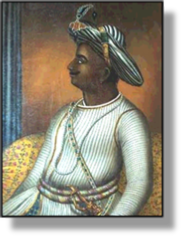 xxxxxAs we have seen, the second of the Anglo-
xxxxxAs we have seen, the second of the Anglo-
xxxxxBut this brought a pause, not an end, to the conflict between the British and the state of Mysore in southern India. Tippu Sahib was an ambitious, energetic leader. In home affairs, he proved an able administrator, making improvements in agriculture, and opening up diplomatic and commercial relations with countries in the Middle East. As a soldier, too, he had more than proved himself during his battles against the Marathas, and by his defeat of the British on the banks of the River Coleroon in February 1782. Indeed, his fighting ability, not to mention his reputation for cruelty, had earned him the title “Tiger of Mysore”. But whilst he had his father’s aggression, he lacked his judgement, and this was to prove his downfall.
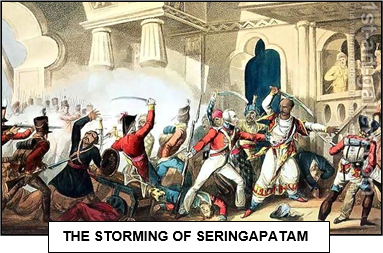 xxxxxThe inevitable third conflict broke out in 1790, when the British under Lord Cornwallis, claiming that Tippu had attacked their ally, the Raja of Travancore, and clearly anxious, in any case, to tame the tiger, went on the offensive. This time it was they who had the support of both the Marathas and the Nizam of Hyderabad. In a campaign lasting over two years, during which Tippu lived up to his nickname, Bangalore and Seringapatam were eventually overrun, and Tippu had no alternative but to concede defeat. He was forced to pay a large indemnity, and to give up half his domains.
xxxxxThe inevitable third conflict broke out in 1790, when the British under Lord Cornwallis, claiming that Tippu had attacked their ally, the Raja of Travancore, and clearly anxious, in any case, to tame the tiger, went on the offensive. This time it was they who had the support of both the Marathas and the Nizam of Hyderabad. In a campaign lasting over two years, during which Tippu lived up to his nickname, Bangalore and Seringapatam were eventually overrun, and Tippu had no alternative but to concede defeat. He was forced to pay a large indemnity, and to give up half his domains.
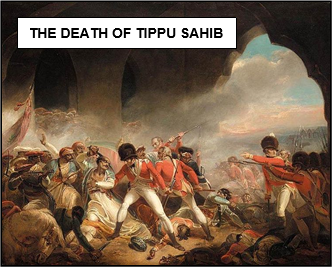 xxxxxIt was a bitter pill for Tippu to swallow, but worse was to come. Later, the British were informed that Tippu had made overtures to the French, entertained envoys from the republican government, and even planted a tree of liberty at his capital Seringapatam! At that time the Revolutionary Wars in Europe were at their height. It only needed the slightest suspicion of French involvement in the affairs of India to provide an excuse for action against an enemy which, in any case, was hostile and needed to be curbed. The governor-
xxxxxIt was a bitter pill for Tippu to swallow, but worse was to come. Later, the British were informed that Tippu had made overtures to the French, entertained envoys from the republican government, and even planted a tree of liberty at his capital Seringapatam! At that time the Revolutionary Wars in Europe were at their height. It only needed the slightest suspicion of French involvement in the affairs of India to provide an excuse for action against an enemy which, in any case, was hostile and needed to be curbed. The governor-
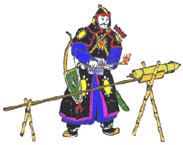 xxxxxIncidentally, it was Hyder Ali and his son Tippu Sahib who revived the use of rockets in battle. As early as 1232 there had been talk of “arrows of flying fire” and “heaven-
xxxxxIncidentally, it was Hyder Ali and his son Tippu Sahib who revived the use of rockets in battle. As early as 1232 there had been talk of “arrows of flying fire” and “heaven-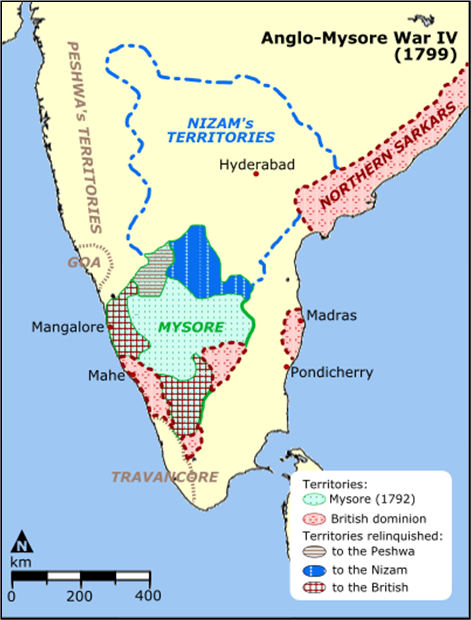 powder”, an inferior form of gunpowder. As late as 1668 a German officer designed a rocket made of wood and weighing 132 pounds. The gunpowder charge added a further 16 pounds, but its effectiveness as a weapon is not recorded.
powder”, an inferior form of gunpowder. As late as 1668 a German officer designed a rocket made of wood and weighing 132 pounds. The gunpowder charge added a further 16 pounds, but its effectiveness as a weapon is not recorded.
xxxxxHyder Ali’s rocket was the first to use a metal cylinder, creating a much higher internal pressure and thus a greater thrust. They were tied to long bamboo sticks and had a range of over a kilometre. They were totally indiscriminate, but nonetheless proved an effective terror weapon, particularly against cavalry. Tippu made improvements to the weapon, and they were used extensively and to good effect in the battles for Seringapatam in 1792 and 1799. The success of these rockets encouraged further development in Europe. As we shall see, in 1805 an English artillery officer named William Congreve, basing his experiments on the rockets used by Tippu Sahib, produced a rocket over three feet long, and this weapon, used en masse, proved highly successful in the Napoleonic wars, especially in the bombardment of Copenhagen in 1807.
Acknowledgements
Tippu Sahib: c1792, artist unknown – British Library, London. Seringapatam: by the English engraver Thomas Sutherland (1785-
G3b-


